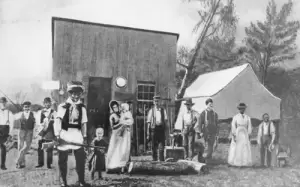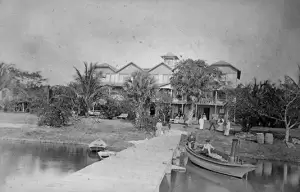Living Off the Land
Burkhardt’s father and uncle owned Lake Worth Grocery, on the present site of Flagler Museum, which they moved on a barge to 207 Clematis Street when West Palm Beach was created, and renamed Pioneer Grocery. The Burkhardt brothers sold staples such as flour and sugar in what was known as half barrels: “Sugar, of course, was 20 pounds for a dollar, and grits was three or four cents a pound. Bacon—white bacon known as sour belly [suet]—that was 12 and ten cents a pound. You’d buy a ham for around a dollar, dollar and a half,” re-counted Henry Burkhardt during a 1962 interview with the Historical Society.
Most pioneers, farmers or not, learned to live off the abundant wildlife on Lake Worth: fish, deer, bear, rabbits, turtles and their eggs. Some planted citrus and other fruit trees, or a vegetable garden.
[Snakes] swam in this lake. Deer swam in this lake. Everything swam in this lake. My father saw [a deer] swimming over kind of close to our dock one morning. He got his gun and went out and shot him, right in the lake.
[Bear] didn’t come around the houses. But if you wanted them for meat, why, you’d go over to the beach and watch ‘em. They were lookin’ for the turtle eggs. My father killed many a bear. Had no ice. [He’d] salt it down and dried it. We used to eat it. But we just lived on venison. Venison dries awfully good. Smoked venison, just cut it in pieces about that long, about that big around, and slice it off when you want it. Better than dried beef. We didn’t dry any more than we could use up before it spoiled.
Papa had everything in his garden. Squash, potatoes and tomatoes and—we had plenty of guavas. And we just lived on Cracker food. ... We had plenty to eat, but it was very different from what we had up in Illinois. ... But we flourished in it and we were happy in it. [Lived] off of the land. We raised everything on it.Belle Dimick Enos (Oral History, 1962, HSPBC)
Community Relations
The pioneers did not all view their Seminole neighbors in the same way.
Jessie Griffin Sheen: They camped on the place just beyond us, we call the “Point,” which is just beyond [St. Ann’s] Catholic Church now. … and come there to get water at the pump. Well, we had a water system in the yard to water the lawn … They’d go in town, get too much to drink. And some nights we’d wake and they’d be out there having an Indian dance on the lawn with the water running and having the best time imaginable!
I was afraid of ‘em when I first came here. First time I saw them … one Indian said to [my husband], “Your squaw?” He said, “Yes, my squaw.” He said, “I like your squaw. You sell me your squaw? … I give you a dollar and a coonskin.” Well you know, I was so afraid of them that night, I could hardly sleep.
Belle Dimick Enos: [W]e made friends with ‘em. One night a man and his wife—two wives —and children slept in our home, and all we could do was let ‘em put the blankets on the floor.
Henry J. Burkhardt II: [W]hen we first established our house down at Lantana, our nearest neighbors was a tent with … 40 or 50 Indians, and they …wanted to know this and that and the other. The women folks never bothered but the men folks were the ones that would ask the questions and so forth. [We] traded with them all the time. … [Billy] Bowlegs III used to come in our place of business and trade. (Oral History, 1962, HSPBC)
Anna Fremd Hadley: They used to come to sell us venison. We had a big, high fence built all the way around our house with a gate and always kept it locked because they’d come right in your home. … [W]e children were scared to death of them, you know, and we’d stand over on the side and they’d throw this meat on the table and carve it. [laughs]… I think my dad had an awful time … He’d say, “Stop,” like this to them when they would start, cause they wanted to sell us the whole works. But you see we didn’t have conditions to keep meat in those days. (Oral History, 1962, HSPBC)
Ice in Boxes
Elisha Dimick had ice brought in from Titusville for the first hotel, his Cocoanut Grove House, which he expanded in 1883. The demand for ice to be made locally came with more hotels. Before he sold it in 1892, Dimick found unexpected uses for the little ice he had on hand, according to his daughter Belle:
One day a young lady boarding there drowned and the closest place, y’know, for an undertaker was Titusville. And the slowest boat[s], y’know, [were] sailboats. And it just had to take all the ice Papa had in the hotel to pack her. She got to Titusville, and I suppose they put her on ice. She was going to Kentucky just in a homemade box that my grandfather made.
On Henry Flagler’s first visit to Palm Beach in 1893, he noted that his hosts, Frederick and Marsena Nelson Robert, stored fresh meat in an icebox at their home. It is not clear where the Roberts obtained their ice, as it was not made and sold locally until hotels—which flourished after Flagler’s arrival—created a demand for it. However, when local businessmen opened the West Palm Beach Electric Light, Ice, and Power Company in 1903, they are said to have bought out an “old ice plant.”





